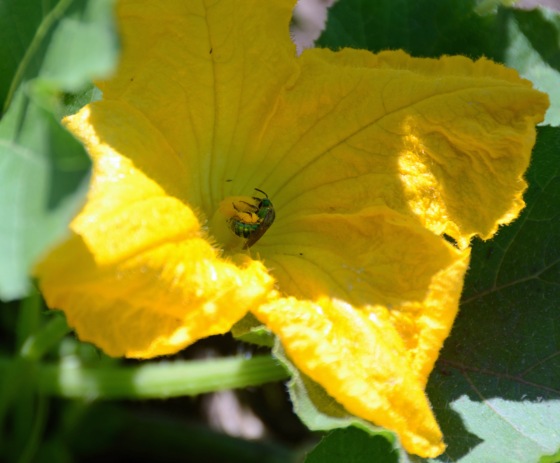Not only is the garden a place for plant growth, it’s a gathering place for insects and animals eager to enjoy nature’s bounty. Sometimes those animals and insects are what we consider pests, such as gophers (the war for the backyard continues!) and caterpillars in my cabbages. But many insects are beneficial in the garden. Bees have been headlining the list lately with the issues over hive collapse disorder, but other bugs are important, too. Ladybugs are a good example, because they eat aphids.
Anyway, here’s a sample of what’s creeping and crawling in my garden lately:
 Here is a bee (it only looks green… it’s not a fly) gathering pollen from a male pumpkin blossom (the pumpkin is one of many plants that is considered “bisexual,” having both male and female flowers… more on that in a minute). Can you see the pollen on the bee’s legs?
Here is a bee (it only looks green… it’s not a fly) gathering pollen from a male pumpkin blossom (the pumpkin is one of many plants that is considered “bisexual,” having both male and female flowers… more on that in a minute). Can you see the pollen on the bee’s legs?
 A ladybug/ladybird beetle chillin’ in the dill. Hopefully protecting it from aphids and other pests!
A ladybug/ladybird beetle chillin’ in the dill. Hopefully protecting it from aphids and other pests!
 Joining the ladybug beetle in the dill is a wasp. Humans definitely value bees over wasps for their pollen spreading services, but wasps are predators and are helpful in their own right. In the lower righthand side of the picture, there is an ant. There’s another in the middle bottom of the photo. I hope the wasp was hunting ants!
Joining the ladybug beetle in the dill is a wasp. Humans definitely value bees over wasps for their pollen spreading services, but wasps are predators and are helpful in their own right. In the lower righthand side of the picture, there is an ant. There’s another in the middle bottom of the photo. I hope the wasp was hunting ants!
 Here’s a crab spider (not sure exact kind) in the marigolds!
Here’s a crab spider (not sure exact kind) in the marigolds!
Oh, and since I mentioned the pumpkin flowers earlier, here’s a brief biology lesson: Many plants are considered bisexual or “perfect,” which means they have both male and female flowering parts.
 Pictured above is the male pumpkin flower with its slender, pollen-containing stamen. Male pumpkin flowers usually come onto the scene before the female flowers, but eventually there are both at the same time. Pollen from the stamen will be carried by bees (or you can be your own bee: pick the make flower and rub the stamen on the female flower) to the female flower’s multi-segmented stigma, shown in the photo below. The pollenated female flower will go on to become a pumpkin!
Pictured above is the male pumpkin flower with its slender, pollen-containing stamen. Male pumpkin flowers usually come onto the scene before the female flowers, but eventually there are both at the same time. Pollen from the stamen will be carried by bees (or you can be your own bee: pick the make flower and rub the stamen on the female flower) to the female flower’s multi-segmented stigma, shown in the photo below. The pollenated female flower will go on to become a pumpkin!
 I have to say I find it endlessly amusing that while some humans seem to consider anything but heterosexuality peculiar,
I have to say I find it endlessly amusing that while some humans seem to consider anything but heterosexuality peculiar,
bisexuality in flowering plants (“angiosperms”) is considered perfect. Oh, the irony.
Anyway, that concludes today’s bug lesson! I hope you’ve enjoyed the up-close-and-personal view of the bug world in my garden. All this talk about bugs has me wanting to re-watch “Ants.” Remember that movie? It was the more adult version of “A Bug’s Life,” and the better of the two in my opinion. Think they’ve got it on Netflix?